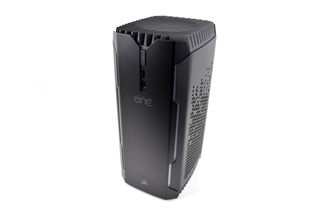Corsair One Desktop PC Review: Cooler than the Rest
Why you can trust Tom's Hardware
Price Analysis & Conclusion
The Corsair One Elite is worthy of its name with its premium configuration, which includes an Intel Core i7-8700K, 32GB (2 x 16GB) of DDR4-2666, and a GeForce GTX 1080 Ti graphics card. The 480GB class PCIe NVMe SSD provides plenty of speedy primary storage, and a 2TB 7,200 RPM HDD gives you plenty of space for a sizeable gaming library. The 500W Corsair SF500 PSU is just enough to power the platform, and the hardware is packed into an impressively small steel and aluminum chassis.

The exterior is a tall and sleek monolithic LED-illuminated masterpiece of a case, with a steel and aluminum construction that makes it a bit heavy, but more than adequately stable. The I/O is consistent with other SFF PCs designed as ultimate living room gamers, with adequate USB connectivity for VR HMDs and multiple display output options, including a front-panel HDMI 2.0 port.
The true star of the show is the One’s cooling system – it’s truly a feat of engineering to cram not one, but two 240mm radiators into a chassis this small, and despite the lack of any fans attached directly to the radiators, the CPU and GPU never exceeded 57C in our testing. The top fan and its aluminum cage are equally impressive, with the heatsink making contact with the aluminum panels to draw heat away from the components, and the 140mm Corsair ML-series mag-lev fan pulling air through the two side-panel radiators and their vents to exhaust the heat. It’s easily one of the quietest cooling designs we’ve ever tested in a SFF gaming PC, and even at full load, the Corsair One is nearly silent.
At $3,000, we wouldn’t expect the Corsair One Elite to appeal to frugal bang-for-your-buck shoppers that are looking for the cheapest way to achieve gaming glory. There are less-expensive configurations of the One available (starting at $2,299 for a previous-gen i7-7700K, 16GB of memory, a GTX 1080 and a 400W PSU), but even the introductory price is quite high and you are still shelling out a considerable overhead compared to the DIY approach (as is the case with almost every OEM and custom shop PC). However, the One is a marvel of a machine, and those that consider themselves among the elite (with a bank account to match) would welcome the top-tier performance, sleek design, and quiet operation of the Corsair One Elite, even at its premium price.
MORE: Best PC Builds
MORE: How To Build A PC
MORE: All PC Builds Content
Stay on the Cutting Edge
Join the experts who read Tom's Hardware for the inside track on enthusiast PC tech news — and have for over 25 years. We'll send breaking news and in-depth reviews of CPUs, GPUs, AI, maker hardware and more straight to your inbox.
-
ledhead11 Thanks for the review. If I had the need or the money. . .Reply
Otherwise it's beautiful for an OEM and quite impressive. -
mlee 2500 Looks like a nice system, one I would consider but for one concern: How upgradable is the GPU? Are you locked into watercooled cards for the life of the machine (which usually extends through at least three generations of GPU's)?Reply -
zodiacfml This proves that intake fans are pointless unless you want to cool something directly, like an HDD or SSD that doesn't actually need much cooling.Reply -
photonboy ZODIACFML,Reply
Uh, first of all intake fans make sense for many PC's... also the Corsair One has an intake fan right on the top.
The air flow is to suck the air in the TOP and then it gets forced out the two radiators.
The Apple design is way better as it uses a core heatsink to mount stuff too and the intake fan is on the BOTTOM which forces air to flow up through the heatsink (that has CPU and 2xGPU mounted) and just goes out the top like a chimney.
Having TWO radiators with pumps seems a little wasteful for the Corsair One. I guess maybe that's what they are stuck with if they mostly use off-the-shelf parts.
I still don't understand why they didn't have the intake fan on the BOTTOM... probably the motherboard needed to be there for the connections to be more convenient and that would have gotten in the way of the fan.

